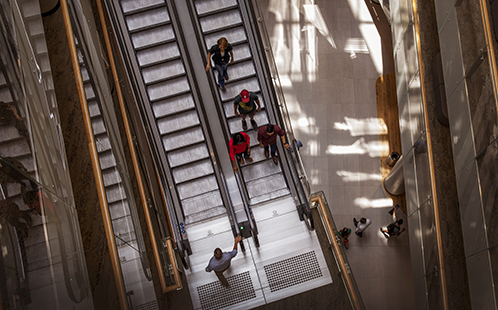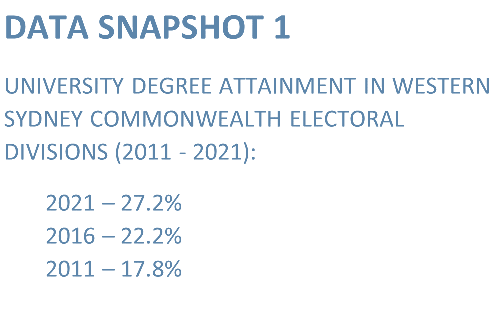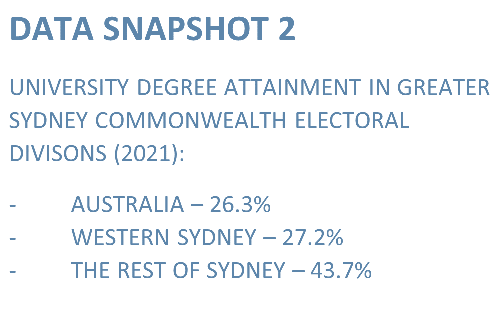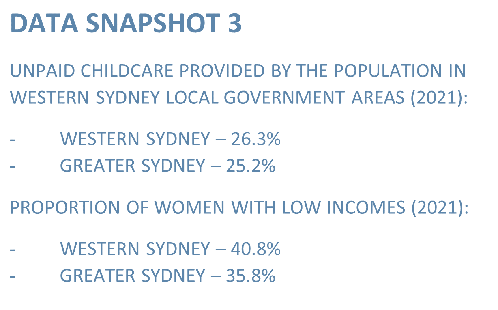You can search for courses, events, people, and anything else.
28th October 2022
A Centre for Western Sydney analysis of recently released 2021 Census data has revealed a remarkable surge in western Sydney’s skilled labour market as well as entrenched inequities that are putting those gains at risk.
On Friday 28 October 2022 the Centre is releasing this analysis in its latest issues paper ‘Untapped talent: Western Sydney’s remarkable but inequitable labour market’.
Director of the Centre for Western Sydney, Professor Andy Marks, and Postdoctoral Research Fellow, Dr Rhonda Itaoui, will present the analysis during a Federal Budget Luncheon hosted by Business Western Sydney. The event will also feature a budget presentation by the Hon. Dr Jim Chalmers MP, Treasurer of Australia.
Professor Marks said the Centre for Western Sydney issues paper reveals a profound and rapid increase in the proportion of western Sydney residents with university-level qualifications across the 14 federal electorates that make-up western Sydney.
“The communities of western Sydney are often characterised as being marginalised, embattled and uneducated,” said Professor Marks.
“However, the latest Census data confirms what many of us in the region already knew. Western Sydney is home to areas of among the most highly skilled, qualified, and culturally diverse workers in the country.”
The Census in 2021 captured a moment in time when just 26.3% of Australians were recorded as having a Bachelor degree or higher. By comparison, across western Sydney federal electorates, that figure is now 27.2%, surpassing the national rate for the first time.
While the data is positive for western Sydney overall, Professor Marks said there are some regions with “patchy” results.
“In the Greenway electorate – which comprises suburbs within the Blacktown City Council – educational attainment is generally high with 35% of the seat’s residents having a university-level qualification,” said Professor Marks.
“While educational attainment is high in Greenway suburbs such as The Ponds (48.2%), Girraween (47.3%) and Schofields (47.1%), elsewhere in the electorate rates drop to just 9.8% in Vineyard and 18.4% in Lalor Park, well below the national average.”
Despite the data showing that western Sydney workers are highly skilled and highly qualified, Professor Marks said the skills of western Sydney workers are significantly underutilised.
“Western Sydney has higher numbers of people from culturally and linguistically diverse backgrounds and newly arrived migrants and refugees, and these Australians are disproportionately represented in unskilled roles in our workforce, despite the evidence that they are increasingly likely to be highly qualified,” Professor Marks said.
Dr Rhonda Itaoui said several spatial inequities remain firmly entrenched in Sydney, related to education, income levels and female labour force participation.
In relation to education, Dr Itaoui flags that while there has been a significant improvement in educational attainment (27.2%), western Sydney still lags the rest of Sydney, where 43.7% of residents have university qualifications.
Dr Itaoui warns that while western Sydney is catching up, this progress could be stalled by the ‘digital divide’ between western Sydney and the rest of Sydney.
“An analysis of the Australian Digital Inclusion Index highlights western Sydney Local Government Areas (LGAs) have the lowest levels of access to digital technologies, including devices and internet, compared with the rest of Sydney,” said Dr Itaoui.
“This is affecting children in schools, particularly those who did not have access to devices and the internet during the lockdowns in 2020 and 2021. If unaddressed, this digital divide will intensify existing education and subsequent labour market inequities in the western Sydney region.”
Another issue that is compounding an already inequitable labour market in western Sydney is the lower levels of female labour force participation in western Sydney LGAs.
“Despite the remarkable increase in women’s attainment of university qualifications over the last decade, females in western Sydney continue to provide more unpaid childcare and earn less than females in the rest of Sydney.”
Dr Itaoui said figures in the 2021 Census show that unpaid care is disproportionately provided by the female population – who are also contending with lower average income levels.
“Compared with greater Sydney, a lower proportion of women in western Sydney earning a high income of over $3,000 per week, and a higher proportion of low-income women earning less than $500 per week,” said Dr Itaoui.
You can access a full copy of ‘Untapped talent: Western Sydney’s remarkable but inequitable labour market’ on the Centre for Western Sydney’s website.
Professor Marks and Dr Itaoui are available for media interviews. To arrange an interview please contact Kathryn Bannon, Media Officer on 0431 718 522 or email media@westernsydney.edu.au.






